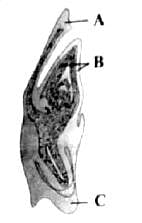Test: Post-Fertilization (Structures & Events) - NEET MCQ
15 Questions MCQ Test Biology Class 12 - Test: Post-Fertilization (Structures & Events)
Milk of tender coconut represents (i) and the surrounding white coconut meal represents (ii).


Identify the wrong statement regarding post fertilization development.
| 1 Crore+ students have signed up on EduRev. Have you? Download the App |
Coleorhiza and coleoptile are the protective sheaths coverging_______and__________respectively.
Identify the parts labelled A, B and C in the given figure and select the correct option.

Identify the incorrectly matched pair:

The function of micropyle in the mature seed is
In the most common type of endosperm development:
The diagram shows stages in embryo development in a dicot where A, B, and C respectively are:

The cells of endosperm have 24 chromosomes. What will be the number of chromosomes in the gametes?
The true embryo develops as a result of fusion of
Identify the parts labelled as A, B, C and D in the given figure and select the correct option from the codes given below


Persistent nucellus is called as______________and is found in __________.
Endosperm development precedes ____ development.
In the given diagram, X represents

Go through the given diagram of a typical dicot embryo. In which of the following all the 3 parts labelled as A, B, C with their respective functions are correctly identified


|
87 videos|294 docs|185 tests
|














